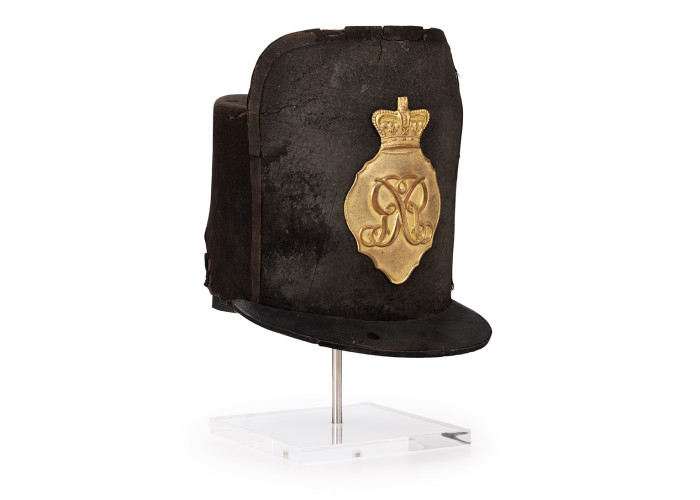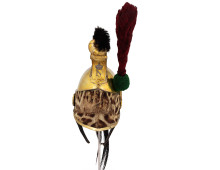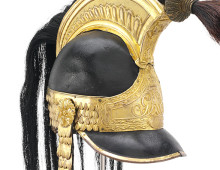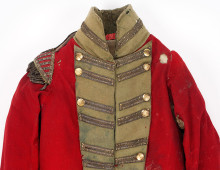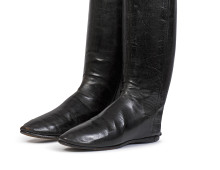Belgic Shako
This is an English infantry soldier’s cap, 1812 pattern, made of beaver felt, bound with black ribbon. This cap was worn by the majority of British foot-soldiers at the Battle of Waterloo.
The brass plate in front has a crown and “GR” cipher, the royal symbol of Britain’s King George III (in Latin, “rex” means “king”). A japanned leather peak complete the cap. The cap is lined with glazed cotton or wool and leather. In wet weather it could be protected with an oilskin cover which prevented it from losing shape.
The cap, or shako, was adapted from the csakos suveg, or peaked cap, of the 18th century Hungarian hussar uniform, a flamboyant style of dress which also had a strong influence on light cavalry uniforms of the period. By 1800 the shako was the most common form of headdress in Europe and the Americas.
A circular from Horse Guards of 18 March 1812 introduced a new form of the infantry cap. Previously, officers had worn the bicorn while the men wore the stovepipe shako, so called from its tall, cylindrical shape, which was the official headdress from 1799 to 1812. After this it was confined to the light infantry. When the new model, with its raised front, was introduced, it was worn by all ranks, the advantage being that it would no longer be so easy for sharpshooters to distinguish and pick off officers.
“Shako” and “Belgic” are later terms, not because this style originated in Belgium (the Portuguese marines were actually the first to wear it in 1797) but because the new caps were worn by British infantry at Waterloo. At the time, though, they were christened “Bang Ups” because they were “bang up to date”.
Edward Neville Macready wrote in his journal after Waterloo: “Our officers killed were Major Chambers, Captain McNabb, Lieutenants Beere and Prendergast, and Ensigns James and Bullen. The wounded were Lieutenant Colonels Hamilton, Bailey, and Vigoureux, Captain Gore, Lieutenants Mayne, Andrews, Elliott, Rumley, Daniells, Harrison, Hughes, Roe [of the] 2nd [Company], Lockwood, Pratt, Warren, and Moneypenny, and those that escaped unhurt were Captain Howard (shot thro’ the cap), Brevet-Major Ryan, and Captains Sinclair and Finucane, Lieutenants Nicholson, Heaviside, Gowan (shot thro’ the cap), Freear, Tincombe, O’Halloran, Latouche, Drake, Rogers (cap shot off) and Ensign McCready.”
This is a reminder of the heavy cost of Quatre Bras and Waterloo (the 2/30th also lost 279 of their original 460 men), but at least Captain Howard and Lieutenants Gowan and Rogers could give thanks for the raised front of the new-style cap.
-
Curatorial info
- Originating Museum: Cornwall's Regimental Museum
- Material: Beaver skin, felt
-
Use this image
You can download and use the high resolution image under a Creative Commons licence, for all non-commercial purposes, provided you attribute the copyright holder.
- Rights Holder: Cornwall's Regimental Museum. Photography Relic Imaging Ltd.
- License Type: Creative Commons
- Related Objects
Find it here
This object is in the collection of Cornwall’s Regimental Museum


